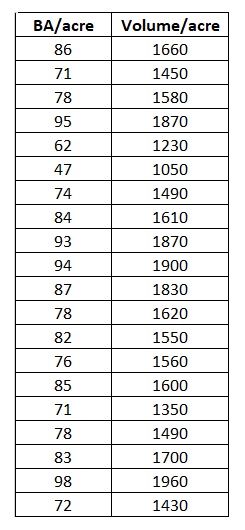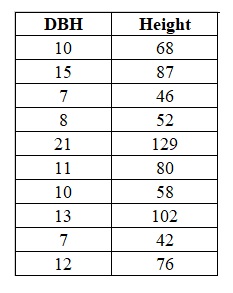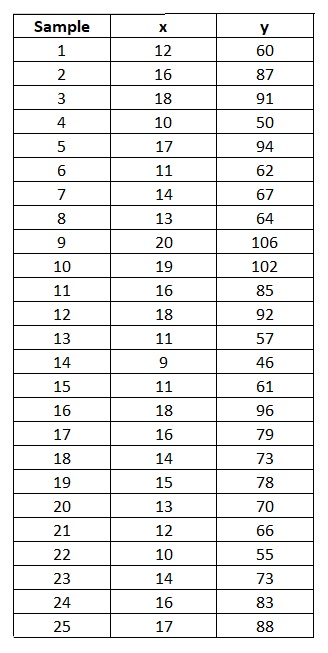F 321 – Assignment #7
Double and 3P Sampling
Objective: This assignment will ask you to apply concepts of regression and ratio estimation to double sampling strategies of forest populations. This will include understanding the merits of both estimation approach and when to apply them.
Student Learning Outcomes: Upon completing this assignment you should be able to:
- Demonstrate your master of the relationship between population variation, desired precision, sampling units, and sample size.
- Discuss the benefits of double sampling and when different combination techniques should be used.
- Apply the calculations of ratio and regression estimation to estimate population parameters.
- Explain the use of 3P sampling in forestry and apply it to summarize an inventory.
1. Calculate how many 1/20th acre plots you would need in order to estimate the mean volume per acre within the stand to within 5%. Assume the stand is infinitely large and use a 95% confidence level.
2. Calculate how many 1/20th acre plots you would need in order to estimate the mean volume per plot within the stand to within 20 cu ft. The stand is 80 acres and use a 95% confidence level.
3. After sampling a 110 acre stand you come up with the following estimators:
Mean 582 cu ft/Acre Standard Deviation 42 cu ft/Acre # of plots 24
With 95% confidence, what is the maximum profit for selling the stand at $280/mbf, assuming 12 bd ft per cubic foot?
4. You are tasked to do a 3P inventory, where preliminary data states that the variation of board feet in a stand is 30% and the contract specifies the 95% confidence interval is to be ± 15% of the mean. Given this information calculate your expected 3P sample size.
5. What are the approaches for recombining data in double sampling? What assumptions must be met in order to utilize each of them?
6. Explain what we would expect to happen to our sample variance if we change from sampling a population with 23 – 1/25th acre plots to using 23 – 1/10th acre plots. Be specific.
7. You have inventoried a 300 acre stand using a count-measure variable radius plot sampling design with 60 plots. From the 60 plots you calculate a population basal area mean of 93 sq ft and from 20 of the plots you also derive estimates of cubic foot volume per acre. Calculate the regression gradient for the subsample, then calculate regression to combine the datasets. Your plot information is listed below:

8. From ten samples of DBH and height calculate the ratio of means estimator. Assume the population mean for height is 68 and population N is 350 to estimate the mean population DBH.

9. Using the ten samples of DBH and Height calculate the mean of ratios estimator. Assume the population mean for height is 68 and population N is 350 to estimate the mean population DBH.

10. Given what we know about the conditions needed to use ratio estimators, how appropriate do you think this technique is for the stand data in questions #8 and 9? Why? (hint: it may be helpful to plot out the data points.)
11. Describe four different potential applications of PPP sampling.
12. Estimate the total cubic-foot volume and its associated variance from the 3P cruise data provided.

13. You harvest the stand in question #12, which is high quality Cyprus, for $41/cubic foot and the harvest is done for $225/load (load = 5,000 bf) and the mill is 54 miles each way at a cost of $0.23/mile. What is your 90% confidence interval for potential profit? Assume you can mill 12 board feet per cubic foot.
14. By looking at the given x, y data pairs, determine if either ratio estimation or regression estimation should be used in estimating the y variable population total. Remember to look at the requirements for using each of these techniques and justify your answers based on these requirements.

Extra Credit (10 points):
Using the Excel dataset provided on Canvas, calculate the BA/Acre, Tree/Acre, and the mean volume (MBF)/acre for each species in each stand inventoried using 1/20th acre plots:
- Tree volume (bf) = BA*0.85*Height*0.75

You decide to harvest the stands and receive a contact with the following specifications,
Stand 1 – 63 acres and is 40 miles from THPL mill & 32 miles from pine and fir mill
Stand 2 – 51 acres and is 28 miles from THPL mill & 36 miles from pine and fir mill
Stand 3 – 46 acres and is 65 miles from THPL mill & 52 miles from pine and fir mill
- Log trucks can haul 5,000 bf/load and cost $225/load and $0.23/mile
- THPL sells for $360/MBF & PIPO sells for $280/MBF & PSME sells for $310/MBF
Calculate your maximum potential profits for each of the stands at the 95% confidence level:
